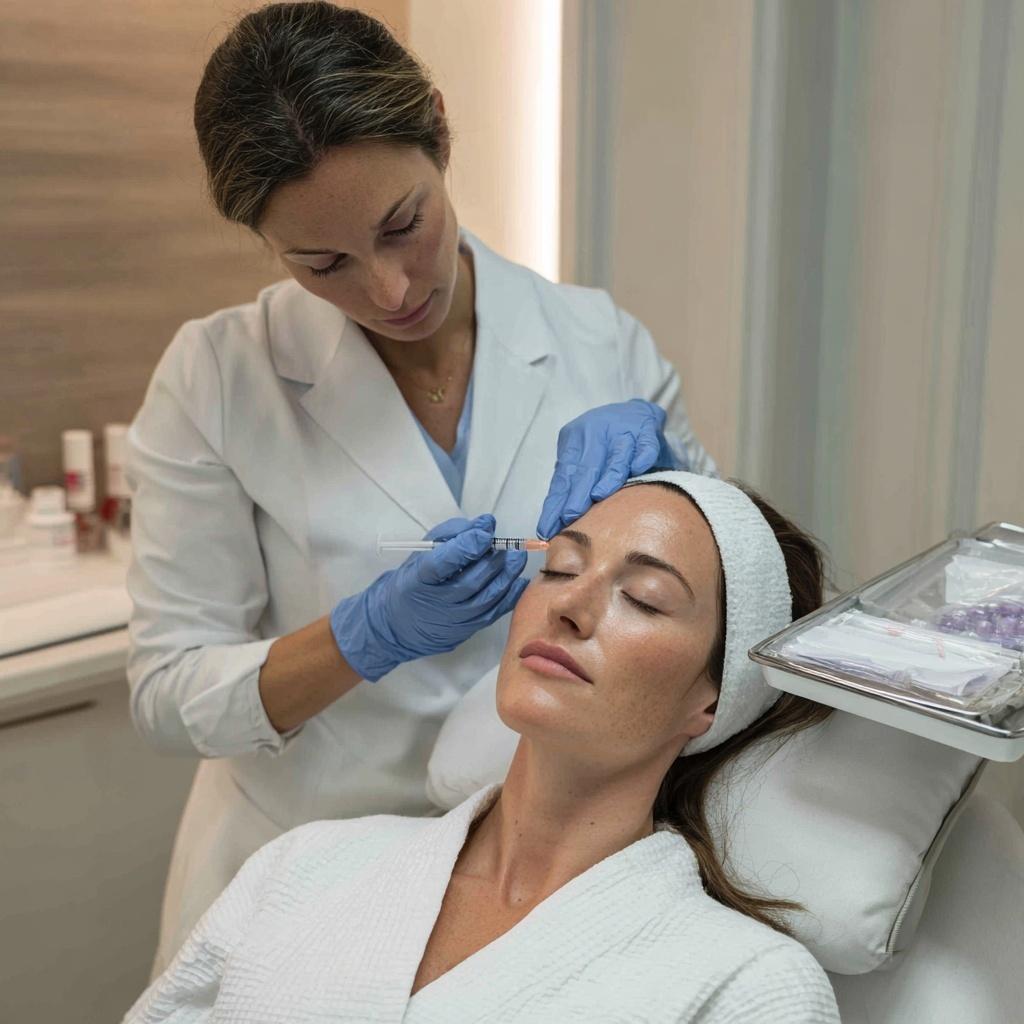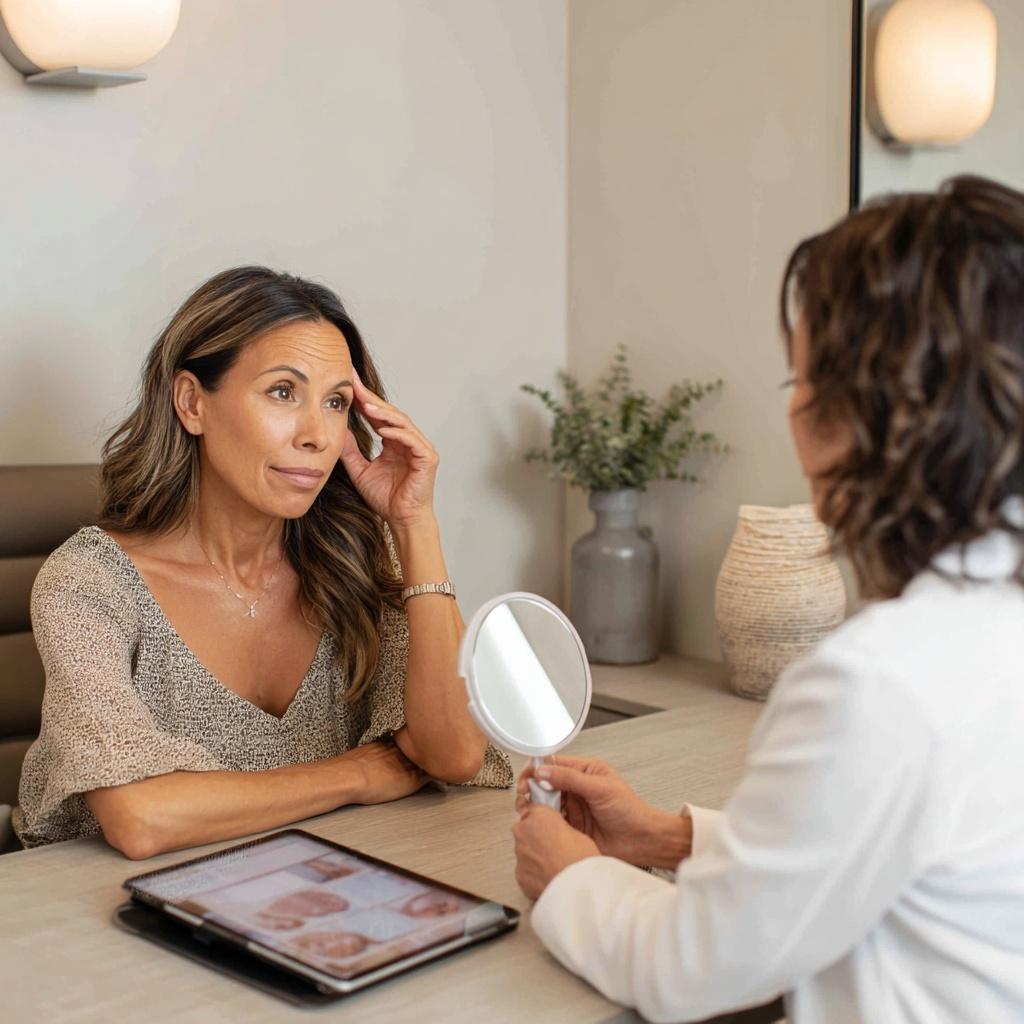
If you’ve noticed your face looking more tired or hollow lately, especially near your eyes and brows, the cause might surprise you. The temple area is often one of the first to lose volume as we age, yet it’s one of the last places people think to treat.
This volume loss in the temples can create a sunken look, make the brow appear lower, and throw off the balance of your face shape, all without a single wrinkle needing to appear.
At Lux Injectables in Clearwater, FL, we use advanced temple filler injection techniques to restore fullness, soften the appearance of aging, and enhance natural facial contour. Our lead injector, Jessica Manges, ARNP, is nationally recognized for her precision and experience in treating the temple region safely and beautifully.
In this guide, you’ll learn exactly how temple fillers work, what to expect during treatment, and how this one small enhancement can bring big improvements to your overall face.
Understanding Temple Hollowing

The temple region sits between the corner of your eye and your hairline. Beneath the surface lies a complex structure of soft tissue, fat pads, temporal bone, and several critical blood vessels and nerves. The superficial temporal artery and middle temporal vein run through this space, along with branches of the facial nerve, which control expression. It’s a tight, dynamic area that is both delicate and essential to your overall facial balance.
Most people don’t realize how much structure and support this small area provides until it’s gone. The fat pads in the temples act like cushions, keeping the upper face smooth and lifted. They also help blend the transition between the zygomatic arch (cheekbone) and the upper brow, creating the youthful curve many associate with vitality. When this area starts to sink inward, everything above it can seem heavier and more aged.
The anatomy and danger zones of the temples make it one of the most technically demanding areas to treat with injectable fillers. A qualified injector must know how to avoid vascular structures and understand how different injection techniques affect the temple’s soft tissue.
Causes of Volume Loss in the Temples
Several underlying factors contribute to the gradual hollowing of the temples. Some are inevitable with age, while others are influenced by lifestyle and genetics.
1. Natural Aging
Hollow temples usually develop slowly due to several factors working together. The biggest culprit is the natural aging process, which includes the gradual breakdown of collagen, elastin, and fat. At the same time, the temporal bone itself can start to shrink, reducing structural support in this part of the face.
2. Genetics and Body Composition
Genetics also play a role. Some people are more prone to sunken temples or lose fat volume earlier in life. Weight loss, intense exercise, and low body fat levels can accelerate this look, even in younger patients.
3. Lifestyle Factors
Certain lifestyle habits such as smoking, poor nutrition, and sun damage can weaken the skin and speed up soft tissue loss in the temples.
4. Subtle Visual Changes Over Time
The changes are subtle at first. You might notice your brow looks heavier, or that your makeup doesn’t sit as smoothly on the outer forehead. Some people describe their eyes looking more tired or deep-set. Others just feel they look older but can’t pinpoint why. In many cases, the missing piece is the temple area, which no longer supports the rest of the upper face as it used to.
Understanding what causes these changes is the first step toward fixing them. Temple filler injections help rebuild this lost volume, improving contour, restoring symmetry, and creating a refreshed, but never artificial appearance.
How Hollow Temples Affect Your Face
Even though the temples are a relatively small area of the face, they have an outsized impact on how youthful you look. Volume loss in the temples can disrupt the harmony between your eyes, brow, and cheekbones. It can also make the zygomatic arch more pronounced, giving a gaunt or skeletal look; especially in profile.
When the temple region sinks in, it changes the way light reflects off your skin. Shadows form where there used to be smooth transitions. The brow can appear lower or heavier, especially in women, making the face look more masculine or tired. It can also deepen the appearance of crow’s feet or create folds in nearby areas of the skin.
Most patients who receive temple filler treatment are amazed at how such a subtle procedure can make their entire face look more awake, balanced, and refreshed. When the temple contour is restored, the eyes look more open, the cheekbones more defined, and the overall face shape more youthful.
The change isn’t dramatic, but it is noticeable in the best way. And because the results are so natural, many people won’t know what changed. They’ll just know you look better.
Types of Fillers & Their Role in Temple Augmentation

When it comes to restoring volume in the temples, several dermal fillers can be used. Each filler has different properties, benefits, and longevity.
Hyaluronic Acid (HA) Fillers – Reversible & Reliable
HA fillers like Juvederm Voluma XC are FDA-approved, water-attracting gels that offer immediate results and can last up to 12–13 months. They’re a safe option, especially for first-timers, and can be reversed if needed.
Calcium Hydroxylapatite (CaHA) – Structure + Collagen Boost
CaHA, found in Radiesse, is a thicker filler that provides instant volume and stimulates collagen over time. It’s ideal for those wanting stronger support and can last up to 18 months. However, it’s not reversible.
Poly-L-lactic Acid (PLLA) – Gradual, Collagen-Based Results
PLLA, used in Sculptra, works by triggering natural collagen production. It doesn’t offer instant volume and requires a series of treatments but is great for subtle, long-term improvements.
FDA-Approved vs. Off-Label Use
Not all fillers are FDA-cleared specifically for temple use. Voluma XC is one of the few with FDA approval for this area. Others may be used off-label, which is common but requires expertise. At Lux Injectables, we prioritize safety and transparency when choosing filler products.
Temple Filler Comparison Table
| Filler Type | Brand Name | Volume Effect | Onset Time | Longevity | Reversible? |
| Hyaluronic Acid | Juvederm Voluma XC | Immediate | Immediate | 12–13 months | Yes |
| Calcium Hydroxylapatite | Radiesse | Immediate | Immediate | Up to 18 months | No |
| Poly-L-lactic Acid | Sculptra | Gradual | Weeks to months | Up to 2 years | No |
Step-by-Step Treatment Journey

Here’s what you can expect at every stage of the temple filler process, from your first consultation to aftercare, so you feel fully prepared and confident.
Step 1: Initial Consultation & Assessment
Your journey begins with a personalized consultation and full-face assessment. We evaluate your facial structure, medical history, and aesthetic goals to determine if temple fillers are the right choice. Jessica Manges, ARNP, may recommend additional treatments like Botox or threads for optimal results. We’ll discuss filler types, show before-and-afters, set expectations, and answer any questions so you feel informed and confident moving forward.
Step 2: Treatment Planning
Once you’re a good candidate, we create a tailored plan based on your facial symmetry, degree of volume loss, and overall goals. Jessica selects the right filler, amount, and injection technique (cannula or needle) based on your anatomy. Combination treatments may be recommended for enhanced balance, and we’ll also estimate how often maintenance might be needed depending on how your body responds to fillers.
Step 3: Mapping and Marking Anatomy
Before treatment, Jessica carefully maps your temple area using anatomical landmarks to ensure precision and safety. The temple has sensitive vascular structures, so this step minimizes risks and ensures accurate filler placement. Every entry point and injection path is planned in detail, giving patients reassurance that their treatment is both safe and highly customized.
Step 4: Aseptic Prep & Anesthesia
Your skin is disinfected with medical-grade antiseptics and numbed with a topical cream to keep you comfortable. Many fillers already contain lidocaine, but we also offer additional pain-relief methods if needed. A sterile, controlled environment ensures a smooth and safe injection process from the moment we begin.
Step 5: Injection Technique
Jessica typically uses a cannula for temple filler due to its safety and precision, though needles may be used in certain cases. Filler is slowly and carefully injected while assessing symmetry and tissue response. Technique is everything here. Gentle pressure and expert anatomical knowledge ensure natural, balanced results.
Step 6: Multimodal Synergy
Sometimes, temple filler alone isn’t enough. Jessica may recommend pairing it with Botox or PDO threads to lift and support surrounding structures. These combination treatments aren’t upsells; they’re based on your specific needs and designed to enhance the overall harmony of your results.
Step 7: Post-Injection Massage & Mapping
After injecting, the area is gently massaged to ensure smooth filler integration. Jessica checks symmetry and may make minor adjustments on the spot if needed. If HA filler was used, small tweaks remain possible shortly after treatment thanks to its moldable nature.
Step 8: Aftercare & Activity Guidelines
Post-treatment care includes avoiding exercise, alcohol, and heat for 24 hours. Keep your head elevated, avoid pressure on the temples, and skip makeup until the next day. Mild swelling or bruising is normal, but serious side effects like vision changes should be reported immediately. We’ll provide full aftercare instructions and schedule a follow-up to ensure everything heals beautifully.
Immediate Results and Recovery
Right after temple filler treatment, you’ll notice an immediate improvement in contour, with smoother hollows and a subtle brow lift. The transition between the forehead and cheek appears more natural, and while results are noticeable, they remain soft and balanced.
Minor swelling, redness, or bruising may occur but typically resolves within 24 to 72 hours. Following aftercare and working with an experienced injector can reduce these effects.
1–4 Weeks Follow-Up
In the first few weeks, filler continues to settle as your skin adjusts and soft tissue relaxes. Any small lumps or asymmetries often smooth out on their own. Hyaluronic acid fillers like Juvederm may also hydrate the skin during this time. At your follow-up appointment, we’ll evaluate your progress, review photos, and determine if a touch-up is needed. Since people metabolize filler differently, some may achieve full results in one session, while others benefit from a gradual approach. Follow-ups also give you the chance to ask questions and align on long-term goals.
Duration of Results
Temple filler results typically last 12 to 13 months with Juvederm Voluma XC, though longevity depends on the product used, your metabolism, and lifestyle. CaHA fillers like Radiesse may last just as long or longer by stimulating collagen, while PLLA (Sculptra) works more slowly and may last 18–24 months.
The temples, being a low-movement area, tend to hold filler longer than areas like the lips. Regardless of type, most patients can maintain results with yearly touch-ups, making temple fillers a long-lasting option with minimal upkeep.
When to Repeat Temple Filler Treatment
We recommend reassessing around 10 to 12 months after your treatment, or sooner if hollowing reappears. Regular maintenance helps preserve facial balance and may require less product over time as collagen builds. For CaHA and PLLA fillers, re-treatment timing varies based on how your body responds.
These collagen-stimulating options often need fewer sessions, especially when paired with threads or Botox. The key to lasting success is consistency and working with a skilled injector who understands facial anatomy and how to tailor your treatment to your evolving features.
Risks, Safety & Client Screening
Understanding the potential risks and how we manage them is essential to ensuring a safe and successful temple filler experience.
Vascular Anatomy & Occlusion Risk
The temple area contains vital blood vessels like the superficial temporal artery and middle temporal vein, making it one of the riskiest areas for filler injections. Accidental injection into or compression of these vessels can lead to serious complications such as tissue damage or, in rare cases, blindness.
At Lux Injectables, Jessica Manges, ARNP, uses advanced safety protocols, including the use of a blunt-tipped cannula and slow, low-pressure techniques to minimize risks. Her deep understanding of anatomy ensures precise filler placement and reduces the chance of vascular injury.
Temple Fillers Common Side Effects
Temple filler treatments can cause minor side effects like swelling, bruising, tenderness, or temporary asymmetry as the product settles. These typically resolve within a few days and can be managed with cold compresses, aftercare instructions, and avoiding alcohol or exercise for 24–48 hours.
While mild discomfort is normal, any signs of severe swelling, skin discoloration, or vision changes should be reported immediately. Our team remains available post-treatment to support you through recovery and address any concerns promptly.
Serious Complications & Management
Though rare, complications like vascular occlusion can occur if filler enters a blood vessel, potentially causing tissue damage or even vision loss. Jessica minimizes this risk using slow injections, aspiration techniques, and meticulous placement.
In the event of a complication, we’re prepared with hyaluronidase to dissolve hyaluronic acid filler quickly and safely. For non-reversible fillers like CaHA, added precautions are taken. Being equipped to recognize and manage risks is a critical part of safe temple filler treatment.
Ensuring Safe Treatment with Jessica Manges
Jessica Manges, ARNP, is a nationally recognized injector with over a decade of experience in dermatology and aesthetics. Her temple filler approach combines clinical precision, artistic eye, and transparent patient education. She evaluates the full face, not just the temples, to create balanced, natural-looking results tailored to your anatomy.
Patients choose her not just for her credentials, but for her clear communication and commitment to safety. At Lux Injectables, you’re in the hands of a trusted expert who prioritizes both aesthetics and your well-being.
Advantages of Temple Filler at Lux Injectables

Choosing the right provider for temple filler can make all the difference in your results, your safety, and how natural you look and feel after treatment.
- Holistic Facial Balance – Temple fillers restore volume and soften harsh transitions between the brow, forehead, and cheeks. At Lux Injectables, we treat the face as a whole to create natural, balanced results that subtly enhance your overall appearance.
- Non-Surgical Lift – Strategic filler placement in the temples can lift the outer brow and improve facial contours with no surgery needed. It’s a quick, minimally invasive option with results that last up to a year or more.
- Fully Customized Treatments – Every face is different, so every plan is too. Jessica personalizes the filler type, amount, and technique based on your unique anatomy and goals for safer, more natural-looking results.
- Proven, Natural Results – Our results are subtle yet transformative. Clients look refreshed and more balanced without appearing overdone. Real patients, real results that are backed by experience and a trusted reputation.
Frequently Asked Questions
1. What does filler in the temples do?
Temple filler restores lost volume in the temples to smooth hollows and support the brow. It helps create a more balanced, youthful face shape by softening harsh angles and lifting the outer eye area. The goal is natural-looking contour, not bulk.
2. How long will temple fillers last?
Temple fillers usually last 12 to 13 months with hyaluronic acid and up to 18 to 24 months with collagen-stimulating fillers. Longevity depends on the filler type, your metabolism, and lifestyle habits. Regular touch-ups help maintain results.
3. What are the downsides of temple fillers?
Common downsides include swelling, tenderness, and bruising that fade in a few days. More serious risks like lumps or vascular issues are rare but possible, especially with inexperienced injectors. Choosing a skilled provider greatly reduces these risks and helps ensure natural, safe results.
4. Has anyone gone blind from temple filler?
Yes, but it’s extremely rare. Vision loss can happen if filler is accidentally injected into a blood vessel that connects to the eye. It’s more common in areas like the nose, but still a small risk in the temple if done incorrectly. That’s why it’s critical to see a licensed medical professional with advanced training in facial anatomy and safety.
5. Is it safe to dissolve temple fillers?
Yes, if the filler is hyaluronic acid-based, it can be safely dissolved with an enzyme called hyaluronidase. This allows for easy correction or emergency treatment. Non-HA fillers like CaHA or PLLA can’t be dissolved, so they require more careful planning. For new patients, HA fillers are usually the safest option.
The Takeaway
Temple volume loss is one of the most overlooked signs of aging, but it’s easy to correct with the right treatment. When this area hollows, it can make your brow look heavy, your eyes tired, and your face less youthful. Expertly placed temple filler restores balance, lifts the upper face, and brings back a refreshed, natural look.
At Lux Injectables in Clearwater, FL, we specialize in precise, safe temple filler treatments tailored to your unique features. Jessica Manges, ARNP, brings extensive experience and national recognition for her expertise.
Book your consultation today to see how a subtle change in your temples can make a big difference in your confidence and overall appearance.
